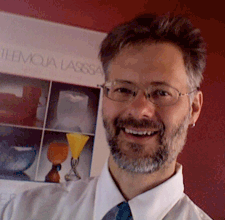Pilgrim Reindeer in Pisa, 1348
a free multimedia novel by
Thomas A. DuBois, University of Wisconsin-Madison
 |
Pilgrim Reindeer in Pisa, 1348 a free multimedia novel by Thomas A. DuBois, University of Wisconsin-Madison |
|
|
|
1. Part I Setting Out 17. From Kalmar to Gotland [September 5, 1347]
There is certainly some subtler humor in this chapter. I enjoyed depicting the merchants' reactions to Bávlos's letter of free conduct: he is what the airline industry calls a "non-rev" passenger, meaning that the ship captain makes no money off him. So they aren't exactly thrilled about having him aboard and keep palming him off on one another until Bávlos hears the name Gotland and remembers the words of Fr. Jens at Hattula. So that is how Bávlos gets to Gotland on the way to Italy....
Depicting a medieval liturgical drama in performance was a lot of fun, and much more vivid for me personally than if I had just translated the text alone. The play is very humorous and entertaining, and I didn't want its verve to be lost on a modern reader. I also wanted to depict the fervent devotion that people felt toward the Virgin—their complete faith that she would see them through come Judgment Day. Nobody's perfect, and it's helpful at the end of the day to know the boss's mother really well, particularly if she is the type of mom who meddles in her son's doings. People were counting on a good word from Mary to help smooth over a life of sin, and so they could cheer for the repentent knight's being saved in the play. If even he found mercy, well then, there's hope for me as well...
Bávlos comes soon to recognize the importance of the Virgin, and this is why he locates her image at the very base of his drum—a spot of great importance in drum iconography—rather than in a spot contiguous with the other images related to Kalmar and Gotland.